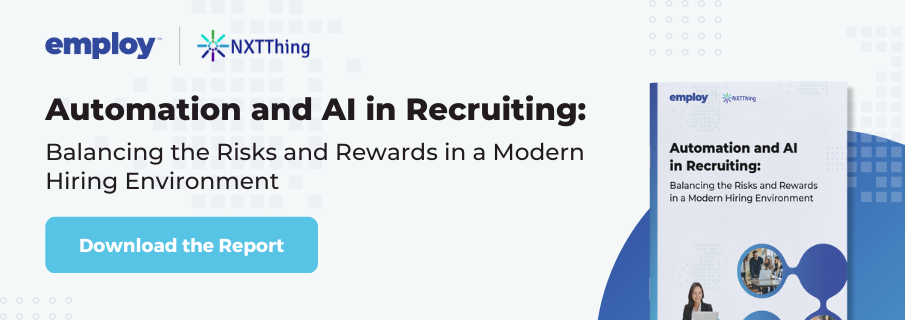By Stephanie Sparks, Content Marketing Manager
Despite economic headwinds, recruiting top talent in today’s job market is still competitive and companies are hard-pressed to find quality talent. With millions of available jobs in the U.S. alone, organizations are under enormous pressure to fill open roles as quickly as possible. Resources are stretched thin, and talent teams are searching for ways to save time, increase efficiency, and streamline processes.
That’s why smart talent acquisition teams incorporate AI into their everyday processes. With AI tools available today, teams can improve recruiting efficiency, and make better, faster decisions without sacrificing hiring quality or the candidate experience. How? Let’s take a look.

What Is AI (And What Are All Those Acronyms)?
Artificial intelligence is a technology that enables machines to replicate human-like intelligence and behaviors, encompassing areas such as machine learning, natural language processing, and neural networks. AI has the power to learn and evolve, responding to data inputs and building upon that knowledge to continually improve its ability to perform tasks.
However, using AI presents a range of ethical considerations, such as the fairness, accountability, and transparency of its decision-making. Without careful consideration of these ethical implications, using AI could result in unintended consequences, potentially doing more harm than good.
While automation has been one of the precursors to the development of AI technologies, automation lacks the learning and decision-making capabilities of AI and is not subject to the same ethical considerations. Addressing these ethical and technological distinctions is crucial to ensure that AI is integrated effectively and responsibly within organizations. Only then can companies unlock the true potential of AI, empowering machines to work alongside humans to achieve shared goals.
Artificial Intelligence In Recruiting
AI is now one of the fastest-growing areas in technology because it increases the speed of tasks that can be completed while improving the quality of outcomes. Examples of automating mundane tasks include sourcing, candidate matching, interview scheduling, and smart assessments.
For more detailed descriptions, let’s look at areas that AI encompasses: generative AI, machine learning, natural language processing, optical character recognition, and sentiment analysis.
Generative AI: Draft Compelling Recruiting Content
Generative AI relies on previously created data (images or content already existing online) to create and generate new content. In talent acquisition, it’s often used to draft job descriptions, recruitment ads, employer branding elements, outreach emails, social media posts, and more.
ChatGPT is a popular form of generative AI recently introduced that has already significantly impacted recruiting. However, this technology comes with a stern warning from most industry leaders: “Do not enter proprietary information into ChatGPT.”
Although ChatGPT has a reputation for pulling analytic insights from your confidential data, open AI means that information is now available for anyone using ChatGPT. Generative AI learns and retains anything and everything entered into the program, so beware of its power and presence.
Machine Learning: Predict Patterns and Make Time-Saving Recommendations
With machine learning (ML), computer systems use algorithms and statistical models to perform a specific task without explicit instructions, relying on patterns and inference instead. Some refer to this as conversational AI or “generative AI with guard rails.”
Simply put, the machine works to find patterns in data and then applies them.
For example, online retailers use ML to recommend products based on previous purchases in the consumer landscape. Machine learning is beneficial for recruiters who can leverage it to automatically send the right jobs to suitable candidates based on their career site activity, professional experience, and personal interests.
With that heavy lifting managed, recruiters can spend quality time conversing with candidates who are the most qualified, clearly motivated, and truly excited about joining the company. ML can further support these conversations by sending supporting messaging at the right time and through the right channel to ensure the highest candidate engagement rates.
Natural Language Processing: Learn, Speak, and Analyze the Language of Every Candidate
Natural language processing (NLP) helps computers understand, interpret, and manipulate human language. Virtual home assistants like Alexa, Google Assistant, and Siri are all ways to engage with NLP systems daily.
Recruiting, screening, interviewing, and hiring activities now occur across multiple channels, including email, text, and social media. This allows for more opportunities for candidates to express their unique personalities with emojis, memes, and a more casual tone. Through NLP-powered chatbots, AI can help recruiters decipher these interactions accurately and quickly to accelerate applications and screening efforts.
NLP can also scan and anonymize content that might contribute to conscious or unconscious bias in the candidate screening process. With workforce planning becoming more global daily, it’s also useful for localized employer branding and hiring efforts.
Optical Character Recognition: Translate Images Into Useful Information
Optical character recognition (OCR) is the electronic or mechanical conversion of images of typed, handwritten, or printed text into machine-encoded text. It may sound complicated, but many of us already interact with OCR regularly when we deposit a check via front and back pictures submitted through our mobile banking apps.
OCR can be deployed within talent acquisition to enable job seekers to scan resumes and other required documentation straight from their smartphones. The efficiency of the experience not only accelerates the application process but also creates a positive candidate experience. For example, many applicants complain (rightfully so) about having to input their resumes multiple times. Think about recruiting platforms that leverage OCR within their systems, creating a simple snap-and-apply feature.
Sentiment Analysis: Understand Candidate’s Interest
Finally, there is sentiment analysis, a subset of NLP. Sentiment analysis is the interpretation and classification of emotions (positive, negative, and neutral) within text data using text analysis techniques.
Using sentiment analysis, chatbots can pre-screen candidates by gauging responses to a pre-populated list of questions as positive, neutral, or negative. Sentiment analysis never presumes to qualify or disqualify a candidate completely. Rather, candidate sentiments are translated and give recruiters the information they need to make the best qualification decisions.
The Time for Leveraging AI Has Arrived
If conversations on social media and in the popular press aren’t apparent enough, consider this your official notification: AI is no longer the future; it’s the present.
Whether in response to the labor market, or the heavy competition to nab top talent before other businesses, it’s clear recruiters and companies are turning to AI technology like never before.
Arm yourself with the insight and understanding necessary to stay competitive by downloading Employ’s latest report: Automation and AI in Recruiting: Balancing the Risks and Rewards in a Modern Hiring Environment.






